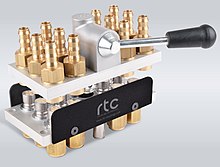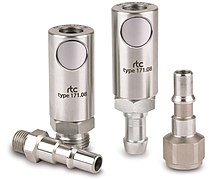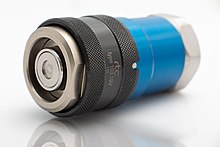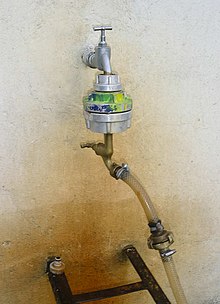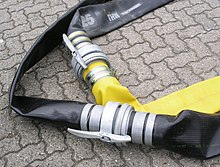Hose coupling
Hose couplings (also quick couplings, mono couplings , multi couplings ) are required to supply machines or systems with gaseous and liquid media as well as with electricity. For flexible and thus economical use, many lines are not permanently connected to one another, but are designed to be separable using quick-release couplings. They enable efficient and reliable connection and replacement of systems, units, devices, etc. The design depends on the intended use, the medium conveyed in the hose ( air , gases , water , oil , acid, etc.) and the pressure conditions in the hose ( Vacuum or overpressure ).
Fire director Erich Giersberg is considered the inventor of the modern hose coupling .
Types of quick coupling
A distinction is made between single (mono-) and multiple (multi) quick-release couplings.
Mono coupling
Monocouplings are single couplings, which means that only one line is connected. The mono-coupling consists of two components, the coupling and the nipple.
Through coupling
Through coupling and (plug) nipple with free passage, both components do not have a valve.
Locking coupling
Sealing coupling and sealing nipple, both components have so-called pointed or needle valves.
Clean break coupling
Clean-break coupling and clean-break nipple, both components have so-called dry or leak-free valves.
Multi-coupling
With multi-couplings , several lines can be coupled at the same time. Multi-couplings are used in particular in cost-intensive systems and machines, i.e. where short set-up times and the uniqueness of lines are particularly important.
Manually operated multi-coupling
The hand-operated multi-coupling usually consists of two carrier plates which hold the installation elements (pneumatic, hydraulic couplings and / or electrical contacts). The coupling and uncoupling of the carrier plates is done by hand.
Power-operated docking system
Docking systems are automatically operated multi-couplings. Docking systems can be operated hydraulically, pneumatically or electrically.
Quick tool change system for robots
Quick tool change systems for industrial robots are special docking systems for precise and safe tool changes (welding guns, grippers, etc.) and consist of a robot-side multi-coupling half, usually several tool-side multi-coupling halves and the matching tool racks.
Application examples
In addition to the terms used previously (mono and multi-coupling), terms derived from the area of application can also be found.
Pneumatic coupling
Pneumatic couplings are couplings for air pressure hoses in pneumatics . It depends on whether the hoses are intended for permanent connection or are often connected and opened again. One part is often designed as a check valve and closes the hose when uncoupling.
The range of pneumatic couplings also includes compressed air safety couplings. With their unique residual pressure control, they reliably prevent the dangerous whip effect when uncoupling compressed air hoses. Complete unlocking is only possible when the pressure on the nipple side has fallen below a safety-relevant switching threshold.
Pneumatic couplings or compressed air couplings must be selected in such a way that when they are coupled or uncoupled they do not throw the coupling part dangerously away from the pressure (ISO 4414).
Hydraulic coupling
Hydraulic couplings are used for hydraulic devices, for quick tool changes, e.g. B. when switching excavators from grab to shovel . A basic distinction is made between screw couplings and plug-in couplings . The fire brigade also has such couplings for the hydraulic rescue kit. Normally these have to withstand much higher pressures (up to 1000 bar )
Hose coupling for gases
Gas hose couplings are used in industry and trade. With gas hose couplings (one-hand quick couplings), tools can be connected or hose lines can be extended quickly and without tools. The gas hose couplings are available for many technical gases (fuel gases) such as acetylene, hydrogen, ethene, natural gas, propane, butane as well as oxygen and compressed air. Gas hose couplings are manufactured in accordance with the EN 561 standard and are coded for different types of gas (fuel gas, oxygen or non-flammable gases). There are matching coupling pins made of stainless steel according to the standard for the couplings.
Hose coupling for water
Water hose couplings are used in industry, in gardening and landscaping as well as in the home. For simple coupling or extension of flexible hose lines, such as garden hoses, industrial hoses or suction and pressure hoses; or for connecting flexible hose lines to rigid pipelines. While claw couplings are predominantly used in the professional sector, for example GEKA-plus quick couplings, in the home sector these are predominantly plug-in couplings , for example from Gardena or GEKA.
The couplings used in fire protection for water-bearing fittings in the area of water extraction and water drainage represent a special form of hose couplings . Today, the bayonet couplings are mainly used throughout Europe .
Chemical coupling
For safety, functional or environmental reasons, it may be that clean break couplings have to be used. They have flat valves on the front side, so-called low-leakage valves or dry valves. The valves in these quick-release couplings are based on the principle of volume displacement, which means that coupling is possible with almost no air entrapment and uncoupling with almost no loss of media.
Couplings for domestic use
Various systems have also spread for garden hoses. The simplest is the Dutch screw connection . However, a plug-in coupling from Gardena , which offers complete systems , has also become widespread .
Loading coupling
Loading couplings are mainly used in the chemical industry for loading dangerous and environmentally harmful substances. They are usually equipped with an breakaway system. Thanks to flexible, movable separation points within the pipeline, safe loading is possible, for example in wagons or ships, even if the transport elements are moving.
Couplings in flood protection
The same couplings are often used for small pumps as in fire protection. In the case of high pump capacities, coupling systems that are not on the same side, such as Perrot couplings, are often used.


